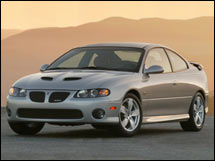NEW YORK (CNN/Money) -
Fans of the classic Dodge Chargers of the late '60s and early '70s -- the "Muscle Car era," when gas-guzzling V-8 beasts ruled the late-night straightaways -- are already gathering in torch-wielding mobs to kill a wretched bastardization, they say, of a once-proud breed.
 |
|
| Official drawing of the 2006 Dodge Charger |
DaimlerChrysler has received reams of hate mail about the upcoming 2006 Dodge Charger, which debuts this weekend at the Detroit Auto Show, according to media reports. Letters have also been showing up in car magazines and Web sites have been posting angry missives.
The new Charger is muscular, though. It has much in common with its powerful siblings, the Dodge Magnum wagon and Chrysler 300C sedan. All three share the same underlying engineering and structure. Plus, the new Charger will be available with a beefy 5.7 liter, 340 horsepower "Hemi" engine.
So why are so many classic Charger fans spitting instead of drooling?
It has four doors rather than two.
Call a car Charger -- or Mustang or GTO -- and carmakers bear historical responsibility. Muscle cars, like Old West gunslingers, are part of America's mythic past. Remake a muscle car and you risk tampering with a treasured past, at least as far as America's legions of devoted motorati are concerned.
The "Goat"
DaimlerChrysler isn't alone. A couple of years ago, General Motors announced that it was bringing back the GTO. Initially, cheers resounded. The original Pontiac GTO, affectionately knows as the "Goat" was not just a muscle car, it was the original muscle car, numero uno.
When the 2004 GTO finally appeared, the cheers turned to murmured disappointment. The new GTO is built overseas as a rebadged and re-engined version of the Holden Monaro, a car from GM's Australian subsidiary.
That's not a major problem, though. If there is any other nation that Americans would trust to build a proper muscle car, it is Australia. We've all seen "Mad Max," after all.
 |
|
| Pontiac GTO |
No problem under the hood, either. The car's performance is, it is generally agreed, outstanding.
Door-wise, there is just the pair. No more. Like the original, the new GTO is a coupe.
The problem is the design of the car. It looks like a modern Pontiac with little to distinguish it from any other modern Pontiac.
It would have been almost impossible to design a car that visually called to mind the original GTOs. Few but the most ardent GTO loyalists would have been able to recognize the cues. But the new car does not look like anyone's idea of a muscle car. It does, however, look like just about everyone's idea of a rental car.
Sales have been less than muscular. This year, optional hood scoops were added as well as an even more powerful engine. But production of the car for 2005 has already been scaled back, according to Automotive News.
The Mustang
Of the three muscle cars in our story, the Mustang alone has been in continuous production. Not always proudly -- even Ford executives will joke about the mid-1970s Mustang II -- but certain standards of appearance, at least, have been maintained.
 |
|
| Ford Mustang |
When the Mustang was reworked for 2005, designers clearly set their sights on that brief, leaded-fuel-charged muscle-car era. During that time, the Mustang "pony car" was beefed up, and became larger to fit bigger engines
The 2005 Mustang is a resounding sales success. It makes onlookers flush like a bad high school crush. It doesn't hurt, of course, that the Mustang also costs much less than the GTO and is great gobs of fun to drive.
Most importantly, perhaps, it is a Mustang. With two doors. Just two.
The Charger
After driving the Chrysler 300C and the Dodge Magnum, I was left with one great desire: the Charger.
While some cars look fast even standing still, the 300C most definitely does not. A parked 300C looks happy where it is. The elegant interior is equally staid. All the more shocking, then, is the car's chest-squeezing acceleration. Still, high-luxury pretensions just aren't to my taste.
The Magnum was more to my liking, with its simple, business-like interior and a reptilian body that looks slow, skulking and mean. The wagon body style means more glass and more weight, though, which is evident in the car's handling after it, too, startles with its take-off.
Whether you call it a sedan version of the Magnum or a 300C without all the fluff, the Charger sounded like just the thing and I looked forward to its introduction.
With the new Charger, the folks at DaimlerChrysler clearly want you to see a "muscle car." First of all, it has a Hemi, Chrysler's trademarked name for the high-output V-8 engines. There are even muscle car styling cues that have been left off the other cars called "Dodge Charger" in the intervening years.
Yet, there are those two extra doors. Just like on a nice family car. No other Charger, not even the 4-cylinder ones in the 1980s, had four doors.
Still, if the Charger is a good enough car, and it surely will be very good, car buyers may forgive the transgression of muscle car orthodoxy.
It remains to be seen, however, since the Charger is only formally being introduced this weekend. It will be a shame if a car that is good in its own right fails to connect with customers largely because its name carries so much historical baggage.
Perhaps they should have just called it the Dart, or maybe the Omni, and left it at that. Then we could all just enjoy the car and stop counting its doors.

|

